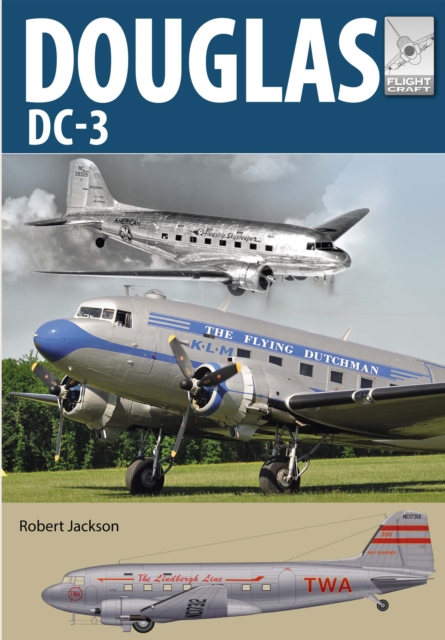
Douglas DC-3 : The Airliner that Revolutionised Air Transport PDF
by Robert Jackson
Part of the FlightCraft series
Please note: eBooks can only be purchased with a UK issued credit card and all our eBooks (ePub and PDF) are DRM protected.
Description
A guide to the plane that changed commercial aviation: "A whopping 109 color photos shows kits in various stages of completion . . . Enjoyed it." -Historical Miniatures Gaming Society
No airliner in the history of commercial aviation has had a more profound effect than the Douglas DC-3. Reliable and easy to maintain, it carried passengers in greater comfort than ever before.
Its origins stem from a design by the Douglas Aircraft Company of Santa Monica, California. Known as the Douglas Commercial One, or DC-1, this new aircraft was revolutionary in concept. It was quickly developed into the DC-2, which led to Douglas' domination of the domestic air routes of the United States, and of half the world.
Experience with the DC-2 led to an improved version, the Douglas Sleeper Transport (DST), first flown on December 17, 1935. This in turn evolved into a 21-seat variant, the DC-3, featuring many improvements. The first American Airlines DC-3 entered service in June 1936, and within three years of its introduction the aircraft accounted for a staggering 95 percent of all US commercial air traffic. From commencement of service to the attack on Pearl Harbor, the DC-3 increased domestic revenue passenger miles more than fivefold. Of the 322 aircraft operated by the country's airlines in December 1941, 260 were DC-3s. At the pre-war peak, 30 foreign airlines operated the DC-3. On the eve of war, the DC-3's scheduled flights represented 90 percent of international air traffic.
In addition to over 600 civil examples of the DC-3, 10,048 military C-47 variants were built, as well as 4,937 produced under license in the USSR as the Lisunov Li-2 and 487 built by Showa and Nakajima in Japan as the L2D. After the war, thousands of surplus C-47s were converted for civilian use. These aircraft became the standard equipment of almost all the world's airlines, remaining in frontline service for many years. The ready availability of cheap, easily maintained ex-military C-47s, large and fast by the standards of the day, jump-started the worldwide postwar air transport industry.
The full remarkable story of the DC-3, and its ancestor the DC-2, is told in these pages, providing a wealth of information for the modeler and the enthusiast alike.
No airliner in the history of commercial aviation has had a more profound effect than the Douglas DC-3. Reliable and easy to maintain, it carried passengers in greater comfort than ever before.
Its origins stem from a design by the Douglas Aircraft Company of Santa Monica, California. Known as the Douglas Commercial One, or DC-1, this new aircraft was revolutionary in concept. It was quickly developed into the DC-2, which led to Douglas' domination of the domestic air routes of the United States, and of half the world.
Experience with the DC-2 led to an improved version, the Douglas Sleeper Transport (DST), first flown on December 17, 1935. This in turn evolved into a 21-seat variant, the DC-3, featuring many improvements. The first American Airlines DC-3 entered service in June 1936, and within three years of its introduction the aircraft accounted for a staggering 95 percent of all US commercial air traffic. From commencement of service to the attack on Pearl Harbor, the DC-3 increased domestic revenue passenger miles more than fivefold. Of the 322 aircraft operated by the country's airlines in December 1941, 260 were DC-3s. At the pre-war peak, 30 foreign airlines operated the DC-3. On the eve of war, the DC-3's scheduled flights represented 90 percent of international air traffic.
In addition to over 600 civil examples of the DC-3, 10,048 military C-47 variants were built, as well as 4,937 produced under license in the USSR as the Lisunov Li-2 and 487 built by Showa and Nakajima in Japan as the L2D. After the war, thousands of surplus C-47s were converted for civilian use. These aircraft became the standard equipment of almost all the world's airlines, remaining in frontline service for many years. The ready availability of cheap, easily maintained ex-military C-47s, large and fast by the standards of the day, jump-started the worldwide postwar air transport industry.
The full remarkable story of the DC-3, and its ancestor the DC-2, is told in these pages, providing a wealth of information for the modeler and the enthusiast alike.
Information
-
Download - Immediately Available
- Format:PDF
- Pages:88 pages
- Publisher:Pen & Sword Books
- Publication Date:30/12/2020
- Category:
- ISBN:9781526760012
Other Formats
- Paperback / softback from £13.59
Information
-
Download - Immediately Available
- Format:PDF
- Pages:88 pages
- Publisher:Pen & Sword Books
- Publication Date:30/12/2020
- Category:
- ISBN:9781526760012










